Lisbon Urban Climate: Statistical Analysis/Approach for Urban Heat Island Effect Based on a Pioneering Urban Meteorological Network
Abstract
1. Introduction
- Can climatopes be validated, reinforcing the measures proposed under the auspices of official literature [35] through UHI outputs?
- What is the direct influence of urban indexes (the net construction index, the implantation index, the open space index, the number of floors in the sensor area, the aerodynamic roughness index, the volumetry index, the compactness index, urban density classes, biomass (maximum annual value), and the sky view factor) on the UHI effect at each analyzed point in Lisbon, including the thermal inertia?
- How can decision makers promote and increase thermal comfort, as well as reduce the effects of the urban heat island in future urban planning?
2. Materials and Methods
2.1. Data Collection and Analysis Methodology
2.2. Chosen Areas and Neighborhoods
2.2.1. Justification for the Choice of Areas
2.2.2. Geographical Location and General Characteristics of the Meteorological Stations of the Lisboa Aberta (CML) Network
| Station | Latitude (°) | Longitude (°) | Altitude (m) | Date (Start) | Date (End) |
|---|---|---|---|---|---|
| Sensor 01 Ajuda (Calçada da Ajuda) | 38.7026 | −9.1997 | 44 | 2 June 2021 | 31 December 2021 |
| Sensor 10 Ajuda (Rua Sá Nogueira) | 38.7111 | −9.1951 | 95 | 1 June 2021 | 15 November 2021 |
| Sensor 41 Jardim do Braço de Prata | 38.7444 | −9.0978 | 5 | 1 June 2021 | 1 December 2021 |
| Sensor 42 Benfica (Travessa Francisco Rezende) | 38.7434 | −9.1943 | 90 | 12 July 2021 | 31 December 2021 |
| Sensor 45 Entrecampos (Rua Frei Carlos) | 38.7455 | −9.1571 | 98 | 1 June 2021 | 25 December 2021 |
| Sensor 62 Lumiar (Estrada do Paço do Lumiar) | 38.7705 | −9.1761 | 108 | 1 July 2021 | 20 December 2021 |
| Sensor 66 Parque das Nações (Rua Ilha dos Amores) | 38.7780 | −9.0929 | 5 | 1 June 2021 | 31 December 2021 |
| Sensor 70 Beirolas (Rua Chen He) | 38.7885 | −9.0948 | 4 | 1 June 2021 | 22 December 2021 |
| Sensor 72 Limite Sul Parque das Nações (Rua. Mário Botas) | 38.7586 | −9.0985 | 26 | 14 June 2021 | 31 December 2021 |
2.2.3. Critical Analysis of the Installation Conditions of Meteorological Stations in Light of the Good Practice Manual of the World Meteorological Organization (WMO)
- (a)
- Weather shelter (Stevenson shelter);
- (b)
- Meteorological shelter (composed of plates and radiation shield)
2.3. Acquisition of Data Used
Instrumentation, Data, and Software Used to Collect and Process Series
| Type of Station | Characteristics | Uses | |
|---|---|---|---|
| Instruments | Lisbon City Council weather stations | Wireless thermometers with 2G, 3G, and 4G communication Accuracy: ±0.5 °C and 0.1 °C resolution | Air temperature measurement |
| Weather data | Lisbon City Council weather stations | Hourly temperature data at each of the analyzed stations: sensors 01, 10, 41, 42, 45, 62, 66, 70, and 72 | Extraction, filtering, and treatment of air temperature data series for measurement at fixed points and determination of the intensity of the UHI effect in each area |
| Lisbon Airport meteorological station (LPPT) | Hourly data for temperature, cloud cover, and wind strength and direction | Use of temperature data as a regional reference to determine the intensity of the UHI effect at each of the remaining points analyzed. Use of data on cloud cover and wind intensity and direction as a regional reference, according to official methodology [35] | |
| Other data | Information on morphology and other urban characteristics |
| Estimation of the relationship between each of the urban parameters and morphological characteristics of the city with the UHI effect of each location |
| Software | Python Scripts 3.12 | Extraction and processing of data from Lisbon Aberta sensors from CML | |
| QGIS, version 3.16.4 | Extraction of values at each chosen point to be associated with the urban characteristics of the location of each sensor | ||
| RayMan Pro 3.1 Beta | Construction of solar diagrams for each sensor to calculate the SVF | ||
| SunEarthTools v3.0 | Construction of solar diagrams referring to each sensor, combined with the RayMan Pro software, in order to quantify hours of solar exposure and angles of solar incidence on the street surfaces in each of the seasons. | ||
| Surfer v9 | Conversion of data displayed originally in a table into a coloured-map, transforming the x-axis in longitude and y-axis in latitude values, showing the horizontal distribution of UHI effect. | ||
| SPSS Statistics v26 | Statistical treatment of extracted data |
2.4. Analysis and Statistical Treatment Methodology, Linear Regression, and Principal Component Analysis
2.4.1. Variables under Study
2.4.2. Selection of Meteorological and Urbanistic Variables
- Identification, selection, and treatment of meteorological, morphological, and urban variables representative of the municipality of Lisbon;
- Creation of a typology of temperature patterns, based on the identification of main components and cluster analysis.
2.4.3. Main Component Analysis
2.4.4. Model Summary
2.4.5. Loading Components
2.4.6. Cluster Analysis
2.4.7. Data Collection and Quality Control
2.5. Mapping of Outputs
2.5.1. Mapping of the UHI Effect Based on the Chosen Sensors
- (a)
- The comparison of the collected data considered the temperature difference between the thermometric stations and the reference station, Lisboa Portela (LPPT). The reference station, located at the highest altitude (104 m), reflects the behavior closest to the regional meteorological situation and furthest from the anthropogenic effects of urban density. Positive temperature differences indicate that the thermometric stations record higher temperatures than the reference station, and the opposite is true when the differences are negative;
- (b)
- To identify patterns, two periods were selected (daytime and nighttime), following the methodology discussed earlier, which has been employed by other authors [9]. The daytime period includes the time between 10:00 and 18:00, while the nighttime period refers to the time between 20:00 and 06:00 the following day. The objective is to encompass the lowest and highest daily values possible, excluding twilight periods according to the aforementioned methodology;
- (c)
- The classification of daily periods was conducted by individualizing each hour, allowing for the grouping of observations into different categories for the production of maps with vertical sections and the analysis of the altitudinal temperature pattern in each study area (despite the lack of a height effect above the ground, as all sensors are positioned 3 m above the ground, though at different altitudes relative to mean sea level). These thermoisopleth maps (showing altitude factor and maintaining the same height above the ground) use the following variables: altitude, temperature, and time (UTC hours). To understand the influence of various urban indexes, it is recommended to consult Figures S19–S29, which detail the physical conditions, whether natural or anthropogenic, at each sensor’s installation site;
- (d)
- The production of cross-sections along the study areas’ axes, in the NE–SW direction (Ajuda) and North–South (Parque das Nações/Beirolas), enables the verification of air temperature distribution patterns at each UTC hour on 10 July 2021, for each sensor in the parishes of Parque das Nações/Beirolas and Ajuda. This day was selected because it was one of the hottest days of the year 2021, characterized by predominantly clear or slightly cloudy skies, thus allowing for greater energy accumulation on various surfaces and materials. The aim was to study one specific day in order to show the thermal performance/patterns of each axis. So, to do that, a day in which thermal stress occurred was chosen in the hope that it would provide meaningful results in our analysis.
2.5.2. Classification of UHI Intensities
3. Results
3.1. General Results
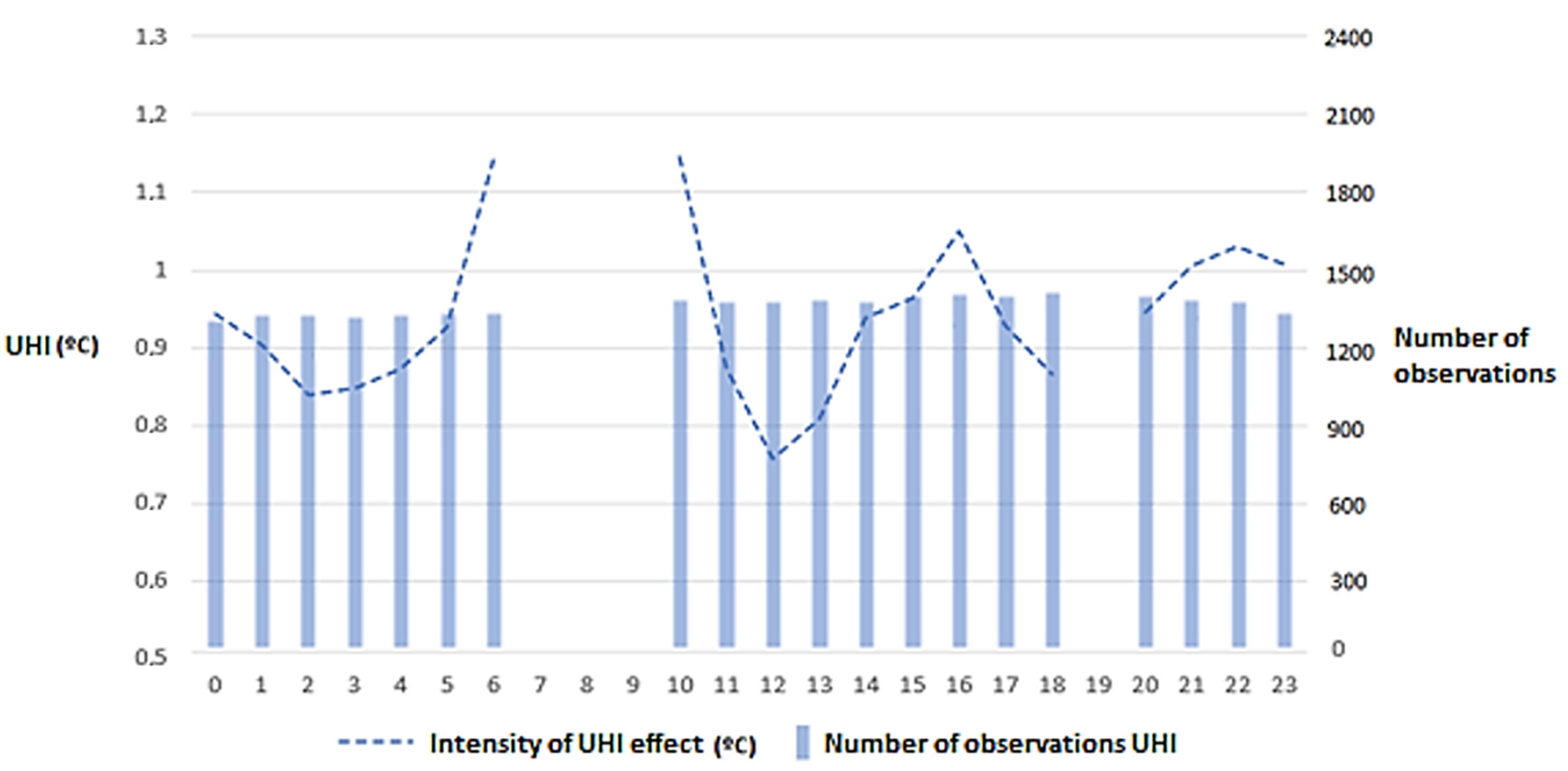

3.1.1. Main Component Analysis
3.1.2. Model Summary
| R | R Square | Adjusted R Square | Std. Error of the Estimate | R Square Change | F Change | Sig. F Change | Durbin–Watson |
|---|---|---|---|---|---|---|---|
| 0.852 | 0.727 | 0.487 | 0.542259 | 0.727 | 3.036 | 0.071 | 1.895 |
| Component | Initial Eigenvalues | ||
|---|---|---|---|
| Total | % of Variance | Cumulative % | |
| 1 | 6.573 | 54.774 | 54.774 |
| 2 | 2.415 | 20.124 | 74.898 |
| 3 | 1.410 | 11.747 | 86.645 |
| 4 | 0.747 | 6.228 | 92.873 |
| 5 | 0.422 | 3.513 | 96.386 |
| 6 | 0.237 | 1.976 | 98.362 |
| 7 | 0.171 | 1.423 | 99.785 |
| 8 | 0.026 | 0.215 | 100.000 |
| 9 | 1.681 × 10−9 | 1.400 × 10−8 | 100.000 |
| 10 | 7.082 × 10−16 | 5.902 × 10−15 | 100.000 |
| 11 | 7.810 × 10−17 | 6.508 × 10−16 | 100.000 |

3.1.3. Loading Component
| Variable | Component | ||
|---|---|---|---|
| 1 | 2 | 3 | |
| Average_value_temp_dev | 0.677 | −0.015 | 0.228 |
| Net_construction_index | 0.893 | 0.005 | −0.355 |
| Implantation_index | 0.592 | −0.774 | −0.211 |
| Open_space_index | −0.592 | 0.774 | 0.211 |
| Number_floors | 0.633 | 0.411 | 0.581 |
| Roughness index (Z0) | 0.890 | 0.382 | −0.080 |
| Volumetry_index | 0.426 | −0.697 | −0.509 |
| Compactness_H/W_index | 0.918 | 0.194 | −0.271 |
| Urban_density_classes | 0.850 | 0.389 | 0.021 |
| Maximum_biomass | −0.848 | 0.250 | −0.305 |
| Sky_view_factor | −0.876 | −0.368 | 0.147 |
| Variable | Average_Value_Temp_Dev | Net_Construction_Index | Implantation_Index | Open_Space_Index | Number_Floors | Roughness Index (Z0) | Volumetry_Index | Compactness_H/W_Index | Urban_Density_Classes | Maximum_Biomass | Sky_View_Factor |
|---|---|---|---|---|---|---|---|---|---|---|---|
| Average_value_temp_dev | 1 | −0.489 | 0.347 | −0.347 | 0.391 | 0.507 | 0.343 | 0.522 | 0.665 | −0.563 | −0.490 |
| Net_construction_index | 0.489 | 1 | 0.583 | −0.583 | 0.369 | 0.801 | 0.187 | 0.897 | 0.761 | −0.698 | −0.798 |
| Implantation_index | 0.347 | 0.583 | 1 | −1 | −0.052 | 0.258 | 0.685 | 0.464 | 0.180 | −0.626 | −0.274 |
| Open_space_index | −0.347 | −0.583 | −1 | 1 | 0.052 | −0.258 | −0.685 | −0.464 | −0.180 | 0.626 | 0.274 |
| Number_floors | 0.391 | 0.369 | −0.052 | 0.052 | 1 | 0.695 | 0.278 | 0.552 | 0.625 | −0.645 | −0.633 |
| Roughness index (Z0) | 0.507 | 0.801 | 0.258 | −0.258 | 0.695 | 1 | 0.060 | 0.914 | 0.861 | −0.674 | −0.936 |
| Volumetry_index | 0.343 | 0.187 | 0.685 | −0.685 | 0.278 | 0.060 | 1 | 0.110 | 0.148 | −0.630 | −0.106 |
| Compactness_H/W_index | 0.522 | 0.897 | 0.464 | −0.464 | 0.552 | 0.914 | 0.110 | 1 | 0.798 | −0.639 | −0.924 |
| Urban_density_classes | 0.665 | 0.761 | 0.180 | −0.180 | 0.625 | 0.861 | 0.148 | 0.798 | 1 | −0.573 | −0.900 |
| Maximum_biomass | −0.563 | −0.698 | −0.626 | 0.626 | −0.645 | −0.674 | −0.630 | −0.639 | −0.573 | 1 | 0.535 |
| Sky_view_factor | −0.490 | −0.798 | −0.274 | 0.274 | −0.633 | −0.936 | −0.106 | −0.924 | −0.900 | 0.535 | 1 |
- The first component is determined by 10 variables: the average temperature deviation value, net construction index, implantation index, open space index, number of floors, roughness, compactness index (H/W), urban density classes, maximum annual biomass, and sky view factor (SVF).
- The second component is determined by three variables: the implantation index, open space index, and volumetry index.
- The third component is determined by two variables: the number of floors and volumetry index.
3.1.4. Correlation Matrix
3.1.5. Cluster Analysis
3.2. Mapping of Outputs
3.2.1. Mapping of the UHI Effect Based on the Chosen Sensors: Deviations in Relation to the Meteorological Station of Lisbon Airport (LPPT)
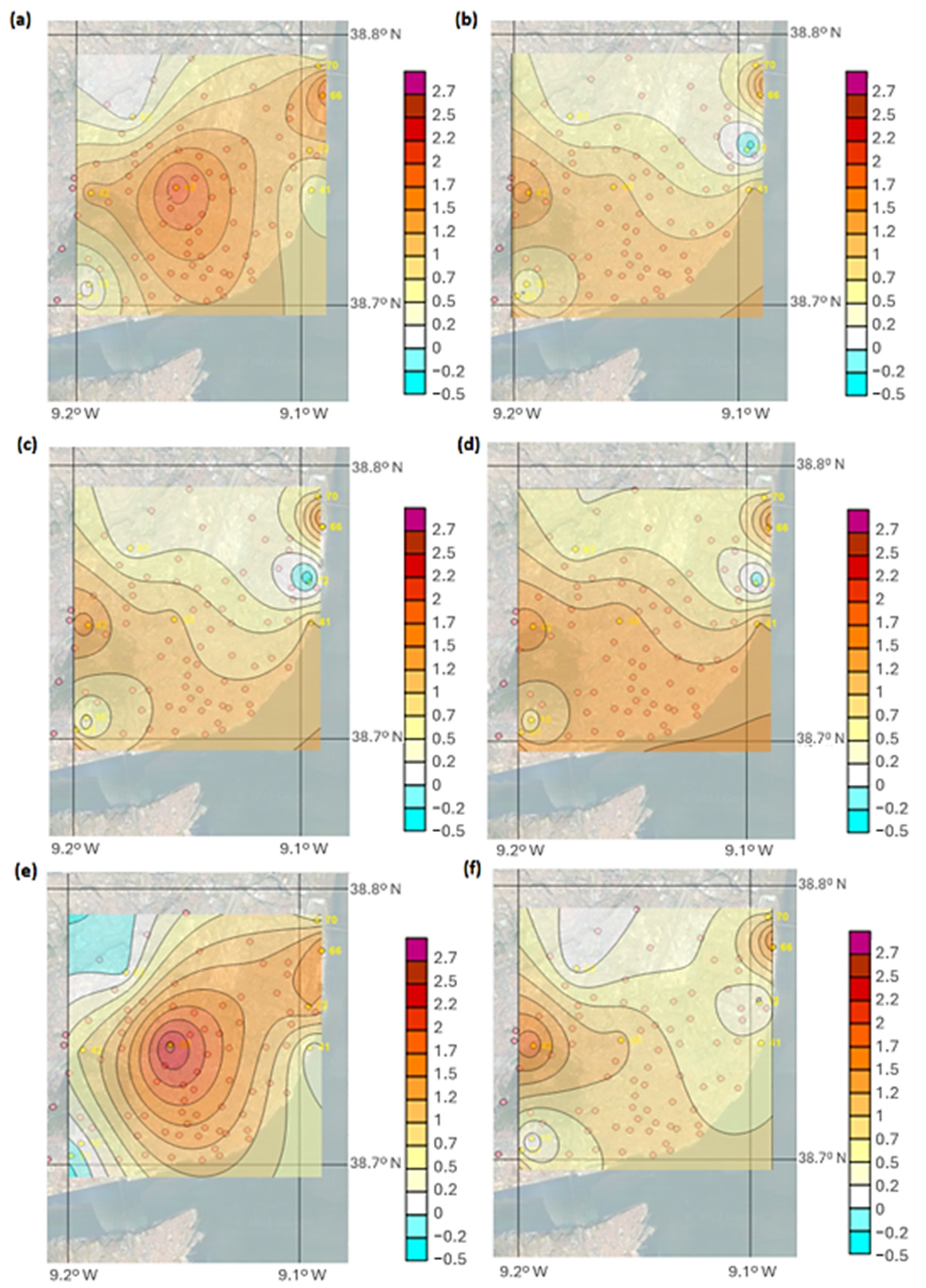
3.2.2. Classification of UHI Intensities
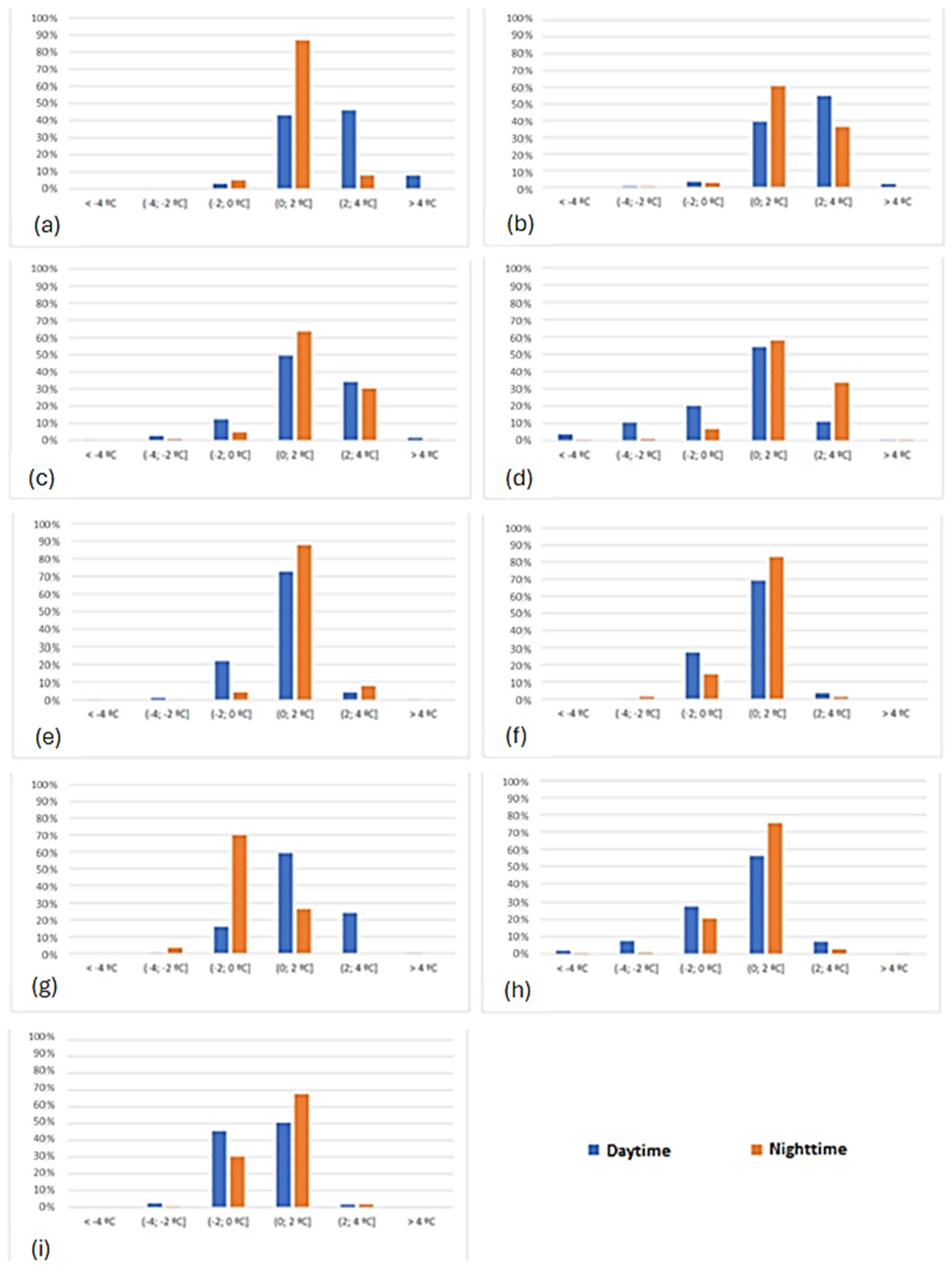

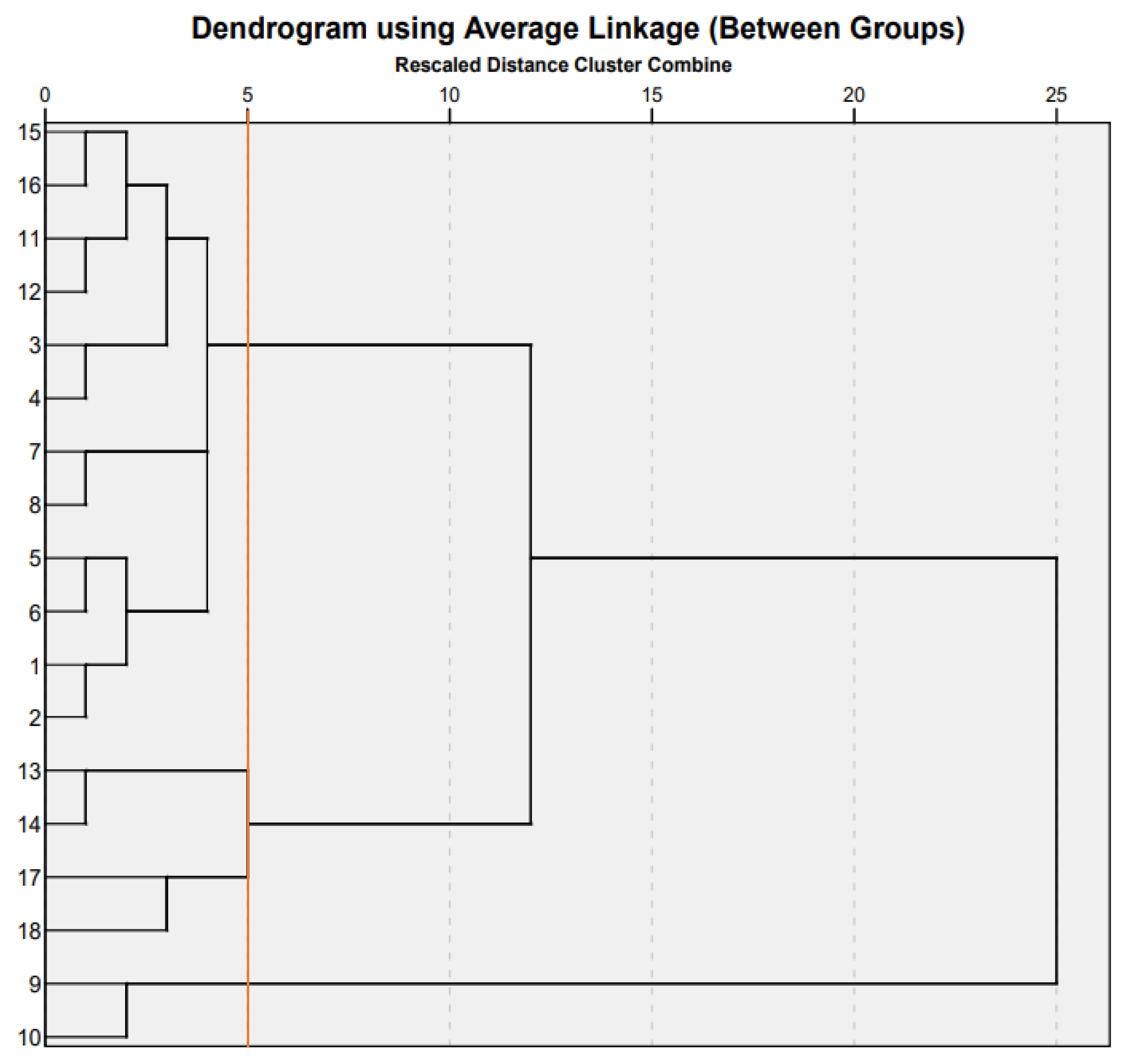
3.2.3. Land Use and Intensity of UHI
3.2.4. Temporal Variation in the UHI Effect

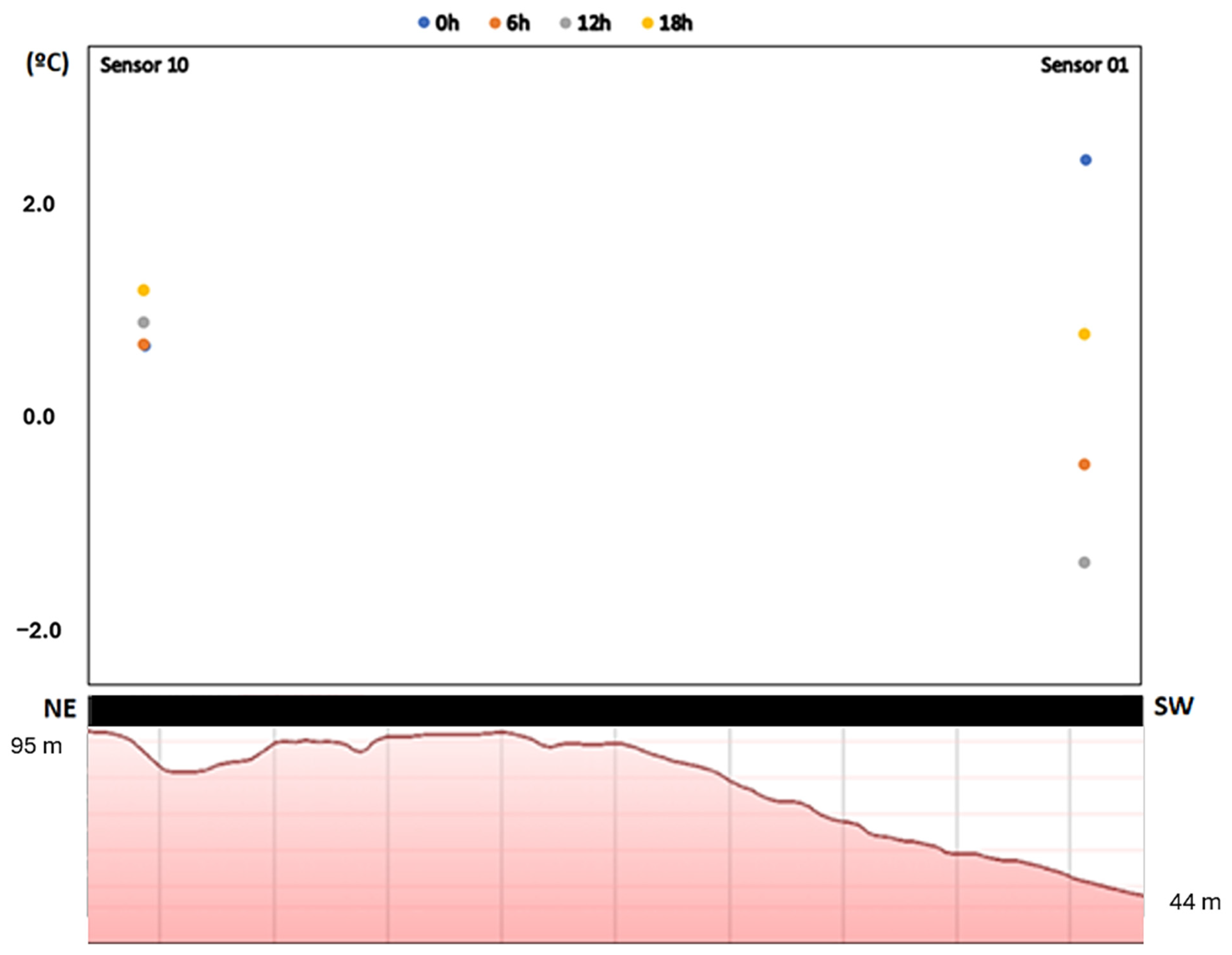
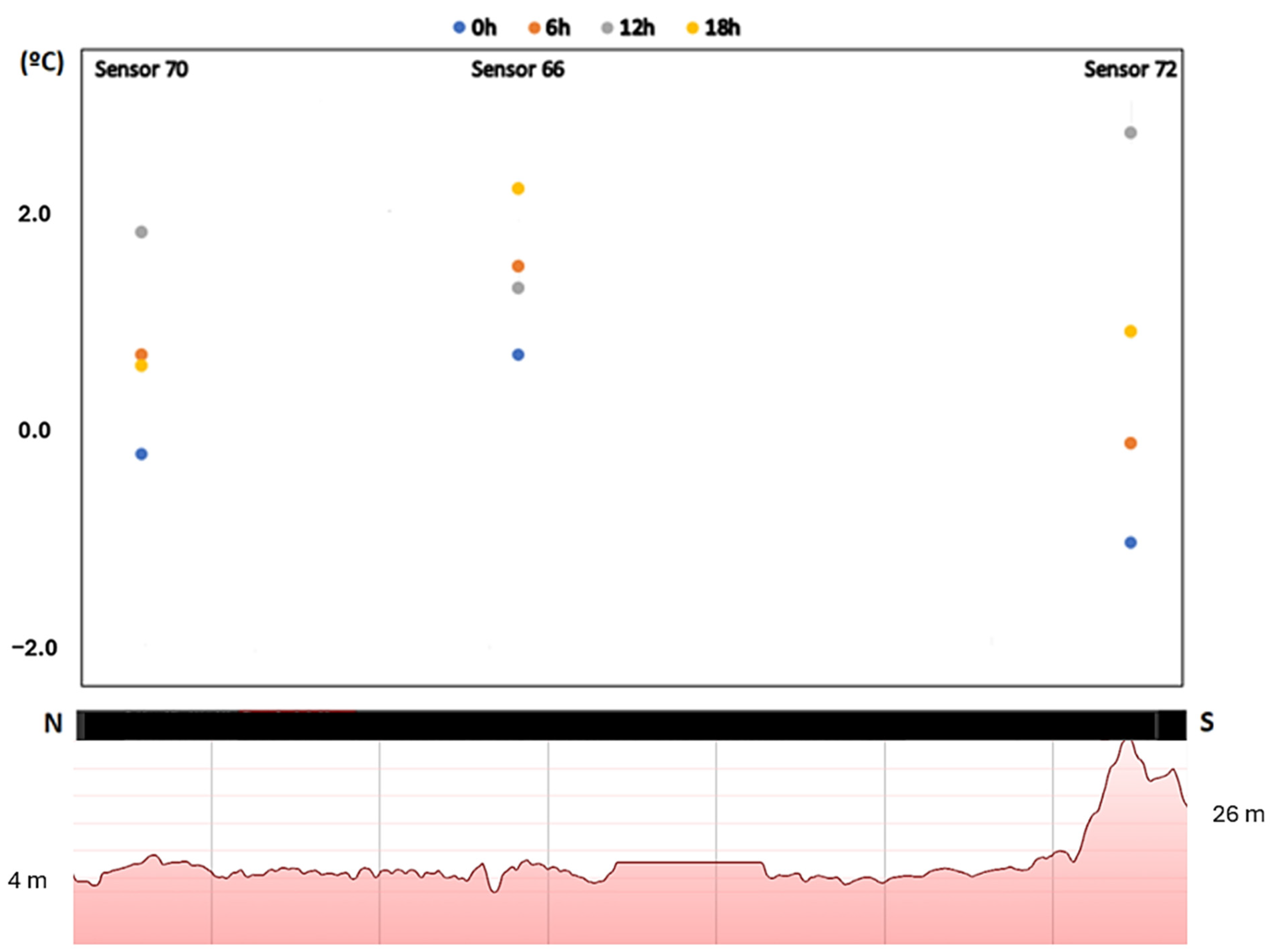
The Case of 10 July 2021: Axis Cross-Section and UHI Effect Per Synoptic Hour (Ajuda)
- The highest altitude;
- The lowest number of floors in the sensor area;
- A lower roughness index (Z0);
- A lower volumetry index;
- The lowest H/W index;
- A greater sky view factor;
- A lower urban density;
- The highest maximum biomass value (between winter and summer).
The Case of 10 July 2021: Axis Cross-Section and UHI Effect Per Synoptic Hour (Parque Das Nações/Beirolas)
- A higher altitude (only in the case of sensor 72);
- The lowest number of floors in the sensor area;
- A lower roughness index (Z0) (exclusively in the case of sensor 70);
- A lower volumetry index;
- The lowest H/W index;
- A greater sky view factor;
- A lower urban density.
- Our aim was to study one specific day in order to show the thermal performance/patterns of each axis. So, to do that, a day in which thermal stress occurred was chosen in the hope that it would provide meaningful results in our analysis. In all the cases analyzed at this point, during the daytime, the less dense areas heat up faster, and the minimum values located in these areas generally are recorded by the sensors between 6 a.m. and 12 a.m. (Figure 12 and Figure 13). This effect is more noticeable in the early hours of the morning and may be associated with the thermal inertia of the materials that make up the city, which is higher in denser areas. This also may be due to the reduced elevation of the sun in the celestial vault during this period, which promotes the extent and duration of areas of shade in places of greater urban density due to the presence of buildings compared to less dense areas. This effect is reduced throughout the day, reaching a point at which there are no thermal differences between the areas towards the afternoon. In fact, the patterns observed on this day were not very different from those of other days, except that of thermal inertia, which was marginally greater.
4. Discussion
4.1. Other Topoclimatic Factors Conditioning the Thermal Patterns Dependent on Other Meteorological Variables
4.1.1. Importance of Prevailing Winds and Ventilation
4.1.2. Cloudiness and Urban Freshness Island (UFI)
5. Conclusions
Supplementary Materials
Author Contributions
Funding
Institutional Review Board Statement
Informed Consent Statement
Data Availability Statement
Acknowledgments
Conflicts of Interest
References
- Milošević, D.D.; Savić, S.M.; Marković, V.; Arsenović, D.; Šećerov, I. Outdoor human thermal comfort in local climate zones of Novi Sad (Serbia) during heat wave period. Hung. Geogr. Bull. 2016, 65, 129–137. [Google Scholar] [CrossRef]
- Huang, K.-T.; Yang, S.-R.; Matzarakis, A.; Lin, T.-P. Identifying outdoor thermal risk areas and evaluation of future thermal comfort concerning shading orientation in a traditional settlement. Sci. Total Environ. 2018, 626, 567–580. [Google Scholar] [CrossRef] [PubMed]
- Huang, C.-H.; Tsai, H.-H.; Chen, H.-C. Influence of weather factors on thermal comfort in subtropical urban environments. Sustainability 2020, 12, 2001. [Google Scholar] [CrossRef]
- Kim, Y.J.; Brown, R.D. A multilevel approach for assessing the effects of microclimatic urban design on pedestrian thermal comfort: The High Line in New York. Build. Environ. 2021, 205, 108244. [Google Scholar] [CrossRef]
- Alcoforado, M.; Lopes, A.; Andrade, H.; Vasconcelos, J. Orientações Climáticas Para o Ordenamento em Lisboa; Universidade de Lisboa: Lisboa, Portugal, 2005; pp. 60–61. Available online: https://www.researchgate.net/publication/262567483_Orientacoes_Climaticas_para_o_Ordenamento_em_Lisboa (accessed on 15 August 2022).
- Alcoforado, M.; Andrade, H. Clima e Saúde na cidade. Implicações para o ordenamento. In A Cidade e a Saúde; Santana, P., Ed.; Edições Almedina, SA, Lisboa: Lisboa, Portugal, 2007; pp. 99–118. [Google Scholar]
- Andrade, H. O clima urbano-natureza, escalas de análise e aplicabilidade. Finisterra 2005, 40. [Google Scholar] [CrossRef]
- Alcoforado, M.-J.; Andrade, H.; Lopes, A.; Vasconcelos, J. Application of climatic guidelines to urban planning. Landsc. Urban Plan. 2009, 90, 56–65. [Google Scholar] [CrossRef]
- Lopes, A.; Alves, E.; Alcoforado, M.J.; Machete, R. Lisbon Urban Heat Island Updated: New Highlights about the Relationships between Thermal Patterns and Wind Regimes. Adv. Meteorol. 2013, 2013, 487695. [Google Scholar] [CrossRef]
- Alcoforado, M.J.; Andrade, H.; Lopes, A. Urban Climate Maps in Lisbon, Portugal. In Urban Climatic Map—An Information Tool for Sustainable Urban Planning (Chinese Version); Chao, R., Ng, E., Eds.; The China Architecture & Building Press: Beijing, China, 2012; pp. 95–110. ISBN 9787112136377. [Google Scholar]
- Soares, P.M.M.; Cardoso, R.M.; Semedo, Á.; Chinita, M.J.; Ranjha, R. Climatology of the Iberia coastal low-level wind jet: Weather research forecasting model high-resolution results. Tellus A Dyn. Meteorol. Oceanogr. 2014, 66, 22377. [Google Scholar] [CrossRef][Green Version]
- Lima, D.C.; Bento, V.A.; Lemos, G.; Nogueira, M.; Soares, P.M. A multi-variable constrained ensemble of regional climate projections under multi-scenarios for Portugal—Part II: Sectoral climate indices. Clim. Serv. 2023, 30, 100377. [Google Scholar] [CrossRef]
- Lopes, A.; Saraiva, J.; Alcoforado, M. Urban boundary layer wind speed reduction in summer due to urban growth and environmental consequences in Lisbon. Environ. Model. Softw. 2011, 26, 241–243. [Google Scholar] [CrossRef]
- Alcoforado, M.-J.; Andrade, H. Nocturnal urban heat island in Lisbon (Portugal): Main features and modelling attempts. Theor. Appl. Clim. 2006, 84, 151–159. [Google Scholar] [CrossRef]
- Reis, C. A Eficiência Térmica no Potencial de Arrefecimento de dois Espaços Verdes em Lisboa. Master’s Thesis, IGOT, Universidade de Lisboa, Lisboa, Portugal, 2018. [Google Scholar]
- Greater London Authority. London’s Urban Heat Island: A Summary for Decision Makers; Greater London Authority: London, UK, 2006.
- Rutledge, K.; Ramroop, T.; Boudreau, D.; McDaniel, M.; Teng, S.; Sprout, E.; Costa, H. Urban Heat Island. 2011. Available online: https://www.nationalgeographic.org/encyclopedia/urban-heat-island/ (accessed on 25 July 2022).
- Sabnis, G. Green Building with Concrete: Sustainable Design and Construction; CRC Press: Boca Raton, FL, USA, 2015. [Google Scholar]
- Oke, T.R. The energetic basis of the urban heat island. Q. J. R. Meteorol. Soc. 1982, 108, 1–24. [Google Scholar] [CrossRef]
- Roth, M.; Oke, T.R. Turbulent transfer relationships over an urban surface. I. Spectral characteristics. Q. J. R. Meteorol. Soc. 1993, 119, 1071–1104. [Google Scholar]
- Garratt, J. Boundary layer climates. Earth-Sci. Rev. 1987, 27, 265. [Google Scholar] [CrossRef]
- Alverson, K.; Bailey, W.G.; Oke, T.R.; Rouse, W.R. The surface climates of Canada. Arct. Alp. Res. 1997, 30, 418. [Google Scholar] [CrossRef]
- Voogt, J.A.; Oke, T.R. Thermal remote sensing of urban climates. Remote Sens. Environ. 2003, 86, 370–384. [Google Scholar] [CrossRef]
- Oke, T.; Mills, G.; Christen, A.; Voogt, J. Urban Climate; Cambridge University Press: Cambridge, UK, 2017; pp. 156–158. [Google Scholar]
- Oliveira, A.; Lopes, A.; Correia, E.; Niza, S.; Soares, A. Heatwaves and Summer Urban Heat Islands: A Daily Cycle Approach to Unveil the Urban Thermal Signal Changes in Lisbon, Portugal. Atmosphere 2021, 12, 292. [Google Scholar] [CrossRef]
- Lopes, A. O sobreaquecimento das cidades. Causas e medidas para a mitigação da ilha de calor de Lisboa. Territorium 2008, 15, 39–52. [Google Scholar] [CrossRef][Green Version]
- Andrade, H.; Alcoforado, M.-J. Microclimatic variation of thermal comfort in a district of Lisbon (Telheiras) at night. Theor. Appl. Clim. 2007, 92, 225–237. [Google Scholar] [CrossRef]
- Arnfield, A. Two decades of urban climate research: A review of turbulence, exchanges of energy and water, and the urban heat island. Int. J. Climatol. A J. R. Meteorol. Soc. 2003, 23, 1–26. [Google Scholar] [CrossRef]
- Oliveira, S.; Andrade, H. An initial assessment of the bioclimatic comfort in an outdoor public space in Lisbon. Int. J. Biometeorol. 2007, 52, 69–84. [Google Scholar] [CrossRef]
- Stewart, I.D.; Oke, T.R. Local Climate Zones for Urban Temperature Studies. Bull. Am. Meteorol. Soc. 2012, 93, 1879–1900. [Google Scholar] [CrossRef]
- Geletič, J.; Lehnert, M.; Savić, S.; Milošević, D. Modelled spatiotemporal variability of outdoor thermal comfort in local climate zones of the city of Brno, Czech Republic. Sci. Total Environ. 2018, 624, 385–395. [Google Scholar] [CrossRef] [PubMed]
- Lau, K.K.-L.; Shi, Y.; Ng, E.Y.-Y. Dynamic response of pedestrian thermal comfort under outdoor transient conditions. Int. J. Biometeorol. 2019, 63, 979–989. [Google Scholar] [CrossRef] [PubMed]
- Lau, K.K.-L.; Tan, Z.; Morakinyo, T.E.; Ren, C. Outdoor Thermal Comfort in Urban Environment: Assessments and Applications in Urban Planning and Design, 1st ed.; Springer: Singapore, 2022. [Google Scholar] [CrossRef]
- Unger, J.; Skarbit, N.; Gál, T. Evaluation of outdoor human thermal sensation of local climate zones based on long-term database. Int. J. Biometeorol. 2018, 62, 183–193. [Google Scholar] [CrossRef] [PubMed]
- Lopes, A.; Vasconcelos, J.; Correia, E. Identificação das ilhas de calor urbano e simulação para as áreas críticas da cidade de Lisboa. In Fase 3—Relatório Final de Cenarização e Mapeamento de Medidas de Mitigação das Ilhas de Calor Urbano; Câmara Municipal de Lisboa: Lisbon, Portugal, 2020. [Google Scholar]
- Oke, T. Initial Guidance to Obtain Representative Meteorological Observations at Urban Sites; WMO/TD-No. 1250; World Meteorological Organization: Vancouver, BC, Canada, 2004; p. 51. [Google Scholar]
- Marôco, J. Análise Estatística—Com Utilização do SPSS, 3rd ed.; Edições Sílabo: Lisboa, Portugal, 2007. [Google Scholar]
- Chang, J.; Shoshany, M. Mediterranean shrublands biomass estimation using Sentinel-1 and Sentinel-2. In Proceedings of the 2016 IEEE International Geoscience and Remote Sensing Symposium (IGARSS), Beijing, China, 10–15 July 2016; 2016; pp. 5300–5303. [Google Scholar] [CrossRef]
- Andrade, H. Bioclima Humano e Temperatura do ar em Lisboa; Universidade de Lisboa: Lisbon, Portugal, 2003. [Google Scholar]
- Lopes, A. Modificações no Clima de Lisboa Como Consequência do Crescimento Urbano. Vento, ilha de calor de Superfície e Balanço Energético. In Tese de Doutoramento em Geografia Física Apresentada à Faculdade de Letras da Universidade de Lisboa; Univerisdade de Lisboa: Lisboa, Portugal, 2003; 354p. [Google Scholar]
- Alcoforado, M.J.; Lopes, A.; Andrade, H. Urban Climatic Map Studies in Portugal: Lisbon. In The Urban Climatic Map for Sustainable Urban Living; Ng, E., Ren, C., Eds.; Routledge: London, UK, 2015; Chapter 16. [Google Scholar]
- Foshag, K.; Aeschbach, N.; Höfle, B.; Winkler, R.; Siegmund, A.; Aeschbach, W. Viability of public spaces in cities under increasing heat: A transdisciplinary approach. Sustain. Cities Soc. 2020, 59, 102215. [Google Scholar] [CrossRef]
- Reis, C.; Lopes, A.; Correia, E.; Fragoso, M. Local weather types by thermal periods: Deepening the knowledge about Lisbon’s urban climate. Atmosphere 2020, 11, 840. [Google Scholar] [CrossRef]
- Oliveira, S.; Vaz, T.; Andrade, H. Perception of termal comfort by users of urban green areas in Lisbon. Finisterra—Rev. Port. De Geogr. 2014, XLIX, 113–131. [Google Scholar]
- Karimi, A.; Mohammad, P.; García-Martínez, A.; Moreno-Rangel, D.; Gachkar, D.; Gachkar, S. New developments and future challenges in reducing and controlling heat island effect in urban areas. Environ. Dev. Sustain. 2023, 25, 10485–10531. [Google Scholar] [CrossRef]
- Halder, B.; Karimi, A.; Mohammad, P.; Bandyopadhyay, J.; Brown, R.D.; Yaseen, Z.M. Investigating the relationship between land alteration and the urban heat island of Seville city using multi-temporal Landsat data. Theor. Appl. Clim. 2022, 150, 613–635. [Google Scholar] [CrossRef]
- Mohammad, P.; Aghlmand, S.; Fadaei, A.; Gachkar, S.; Gachkar, D.; Karimi, A. Evaluating the role of the albedo of material and vegetation scenarios along the urban street canyon for improving pedestrian thermal comfort outdoors. Urban Clim. 2021, 40, 100993. [Google Scholar] [CrossRef]
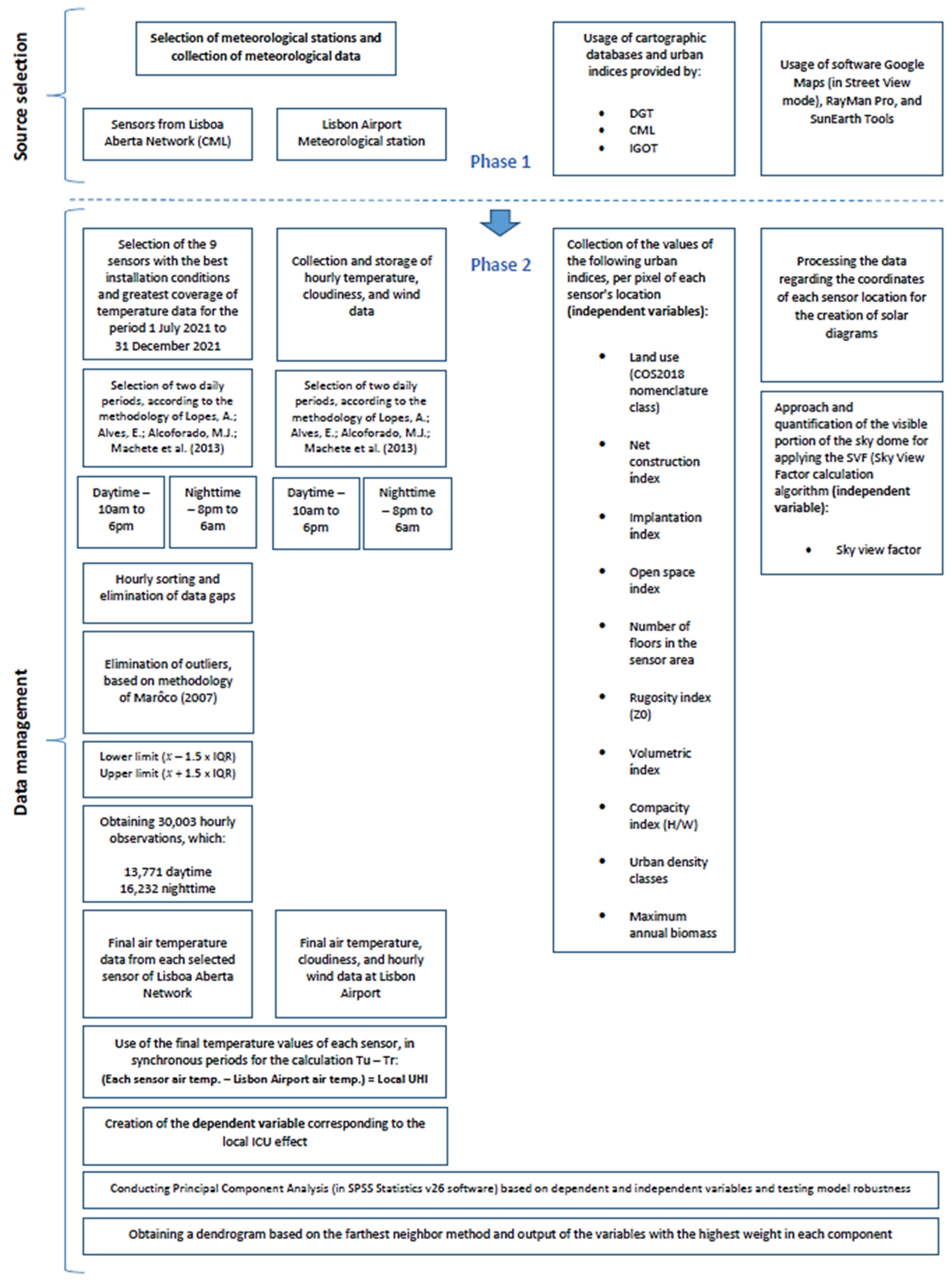
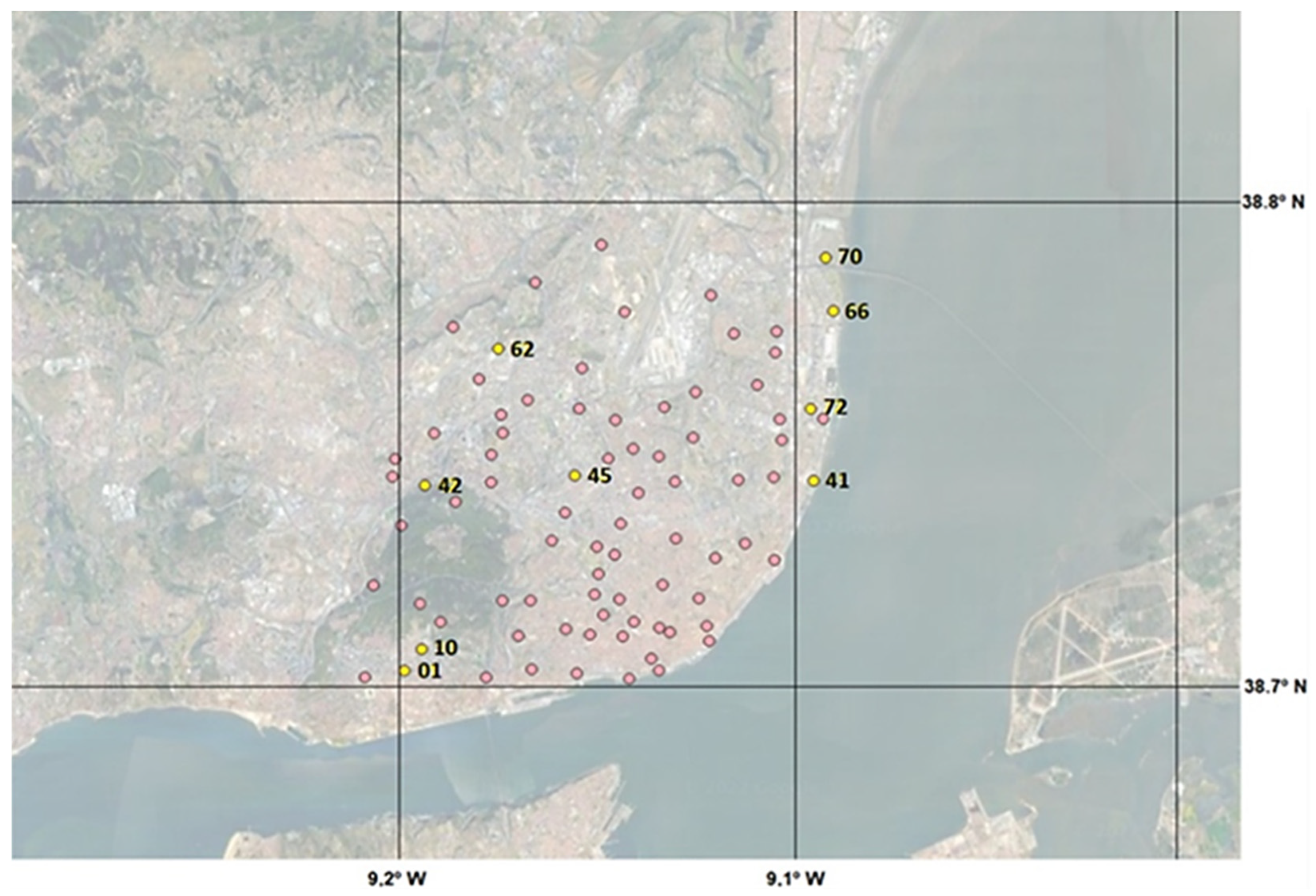
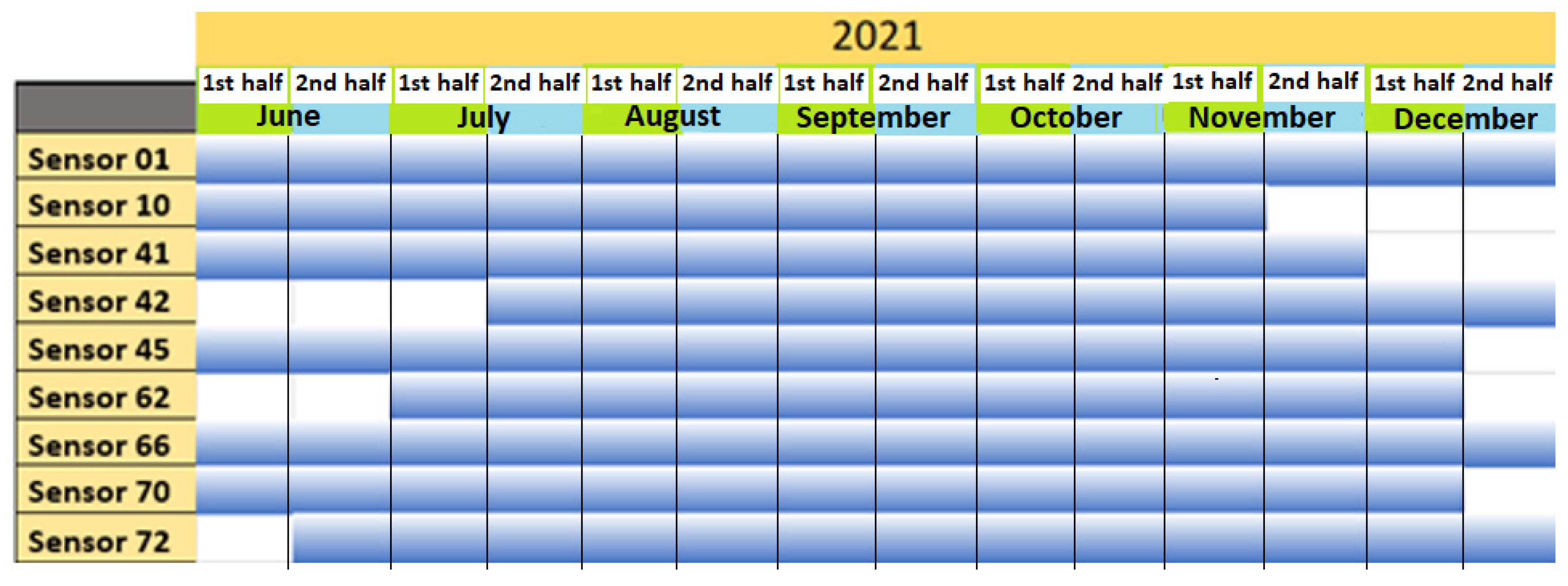
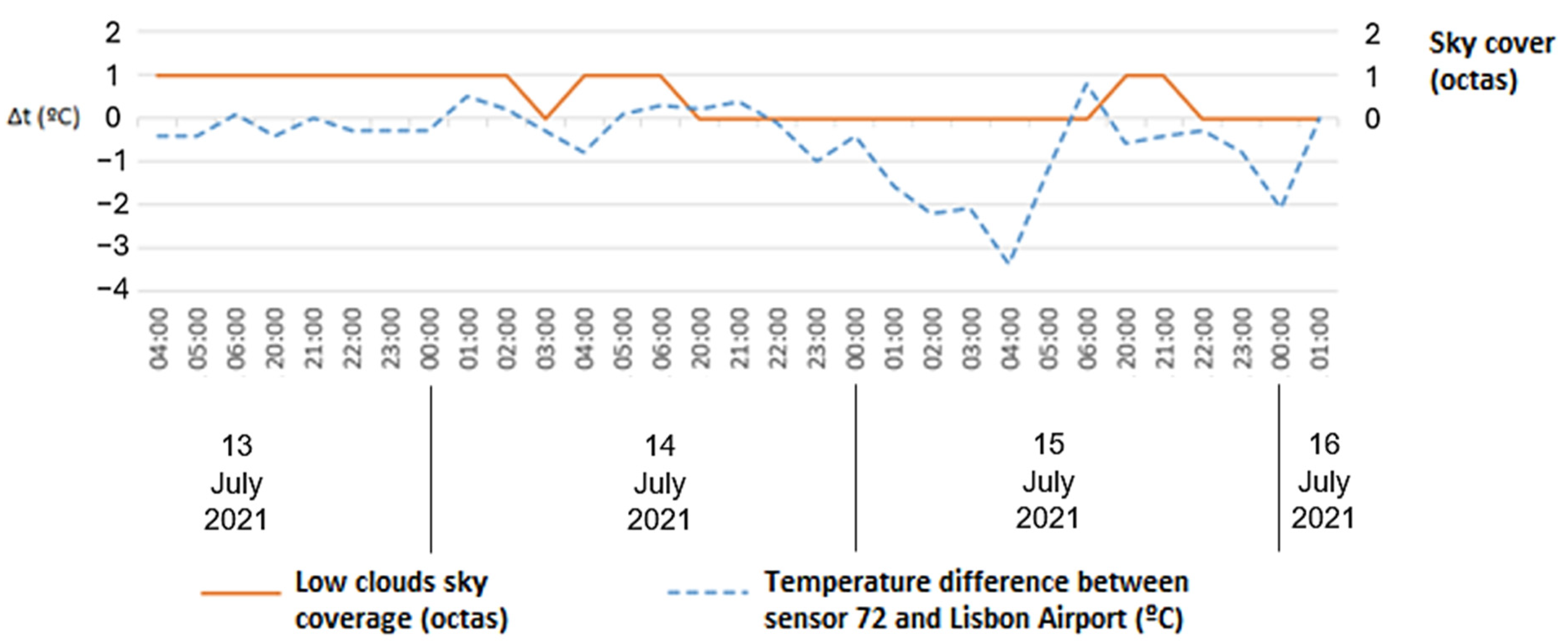
| Variable | Comments |
|---|---|
| Average temperature deviation value | Dependent variable. Difference between each sensor and the reference station. Average of the entire period. |
| Net construction index | Independent variable. The building index establishes the relationship between the building area and the land area on which the operation is based. It is expressed by the formula (ic) i = ΣAj/S. |
| Implantation index | Independent variable. The implantation index establishes the relationship between the implantation area of the buildings and the area of land that serves as the base for the operation, expressed in %. It is expressed by the formula p = (A0/S) × 100. |
| Open space index | Independent variable. The open space index is the inverse of the building index. It is expressed by the formula 1/ic. |
| Number of floors in the sensor area | Independent variable. Determines the average number of floors that make up the buildings on the street where the sensor is located over a 100 m distance, rounded to the nearest unit. |
| Aerodynamic roughness index | Independent variable. Aerodynamic roughness (Z0) is a morphometric index that evaluates surface friction. |
| Volumetry index | Independent variable. The volumetry index relates the volume of existing buildings in a given area (of 100 × 100 m) to the average volume if the cell was fully occupied. It is expressed by the formula (IV) iv = Σ Vj/S. |
| Compactness index (H/W) | Independent variable. This index establishes the ratio between the height of buildings (H) and the width of streets (W). |
| Urban density classes | Independent variable. Urban density classes reflect a relationship between aerodynamic roughness (Z0), compactness index (H/W), and volumetry index (I/V), among other components derived from these. |
| Biomass (maximum annual value) | Independent variable. Adapted from published methodology [15], according to the methodology recommended by the author for the city of Lisbon, expressed in kg/m2. Presence of biomass (kg/m2) = 0.148 + 1.735 × NDVI, a formula that was previously adapted [38] |
| Sky view factor (SVF) | Independent variable. The SVF value reflects the urban geometry of the respective point where it is located, ranging from 0 (zero) to 1, with the value of 1 corresponding to an area without any obstacle that comes between the chosen point and the sky. An SVF of 1 (no obstructions) under clear-sky conditions, receives shortwave radiation all day and emits longwave radiation at night. Different FVC values mean different radiative balances and therefore different energy stores. |
| Daily Period | Element in the Dendrogram | |
|---|---|---|
| Sensor 01 | diurnal | 01 |
| nocturnal | 02 | |
| Sensor 10 | diurnal | 03 |
| nocturnal | 04 | |
| Sensor 41 | diurnal | 05 |
| nocturnal | 06 | |
| Sensor 42 | diurnal | 07 |
| nocturnal | 08 | |
| Sensor 45 | diurnal | 09 |
| nocturnal | 10 | |
| Sensor 62 | diurnal | 11 |
| nocturnal | 12 | |
| Sensor 66 | diurnal | 13 |
| nocturnal | 14 | |
| Sensor 70 | diurnal | 15 |
| nocturnal | 16 | |
| Sensor 72 | diurnal | 17 |
| nocturnal | 18 |
| Naming Class (COS2018) | Descriptive | Mean Value of the UHI Effect | Sensors That Make Up the Class |
|---|---|---|---|
| 1.1.1.1 | Predominantly vertical continuous built fabric (waterproofing greater than 80%) | 1.8 °C | 45, 66 |
| 1.1.1.2 | Predominantly horizontal continuous built fabric (waterproofing greater than 80%) | 1.3 °C | 01, 42 |
| 1.7.1.1 | Parks and gardens | 0.8 °C | 41 |
| 1.3.2.2 | Waste and wastewater treatment infrastructure | 0.5 °C | 70 |
| 1.6.5.1 | Other tourist equipment and facilities | 0.4 °C | 10, 72 |
| 1.1.2.2 | Sparse discontinuous built fabric | 0.2 °C | 62 |
| Climatope [35] | Mean Value of the UHI Effect | Sensors That Make Up the Class |
|---|---|---|
| High-density areas | 1.7 °C | 45 |
| Areas of medium density south of the aerodynamic limit | 1.5 °C | 01, 42, 66 |
| Riverfront | 0.6 °C | 41, 70 |
| Low-density areas | 0.5 °C | 10, 41, 72 |
| Shrub vegetation, herbs and crops | 0.3 °C | 62, 70 |
| Ventilation corridors | 0.2 °C | 62 |
Disclaimer/Publisher’s Note: The statements, opinions and data contained in all publications are solely those of the individual author(s) and contributor(s) and not of MDPI and/or the editor(s). MDPI and/or the editor(s) disclaim responsibility for any injury to people or property resulting from any ideas, methods, instructions or products referred to in the content. |
© 2024 by the authors. Licensee MDPI, Basel, Switzerland. This article is an open access article distributed under the terms and conditions of the Creative Commons Attribution (CC BY) license (https://creativecommons.org/licenses/by/4.0/).
Share and Cite
Vilão, D.; Ramos, I.L. Lisbon Urban Climate: Statistical Analysis/Approach for Urban Heat Island Effect Based on a Pioneering Urban Meteorological Network. Atmosphere 2024, 15, 1177. https://doi.org/10.3390/atmos15101177
Vilão D, Ramos IL. Lisbon Urban Climate: Statistical Analysis/Approach for Urban Heat Island Effect Based on a Pioneering Urban Meteorological Network. Atmosphere. 2024; 15(10):1177. https://doi.org/10.3390/atmos15101177
Chicago/Turabian StyleVilão, Daniel, and Isabel Loupa Ramos. 2024. "Lisbon Urban Climate: Statistical Analysis/Approach for Urban Heat Island Effect Based on a Pioneering Urban Meteorological Network" Atmosphere 15, no. 10: 1177. https://doi.org/10.3390/atmos15101177
APA StyleVilão, D., & Ramos, I. L. (2024). Lisbon Urban Climate: Statistical Analysis/Approach for Urban Heat Island Effect Based on a Pioneering Urban Meteorological Network. Atmosphere, 15(10), 1177. https://doi.org/10.3390/atmos15101177






